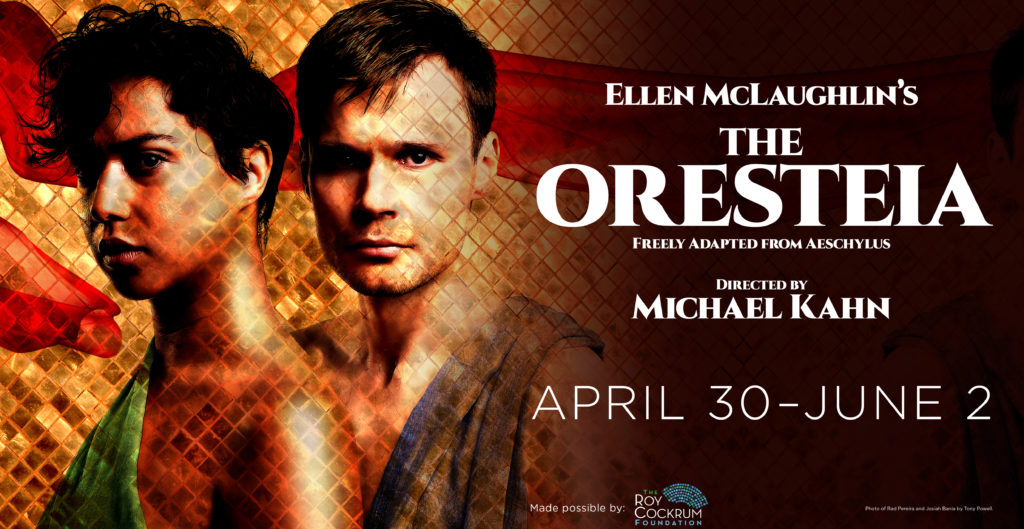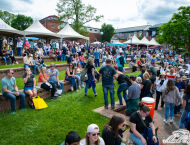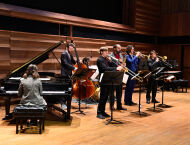Culture
 Image: Courtesy of Shakespeare Theatre Company
Image: Courtesy of Shakespeare Theatre Company
Inside The Oresteia’s Original Score with Composer Kamala Sankaram
April 30, 2019 @ 12:00am
Kamala Sankaram has worked within many musical mediums throughout her career. With a background in opera, she eventually moved into composition, and even has her own band called Bombay Rickey. The theme that weaves her work together is combining global music elements with technical prowess to evoke the exact feeling needed to fully engage audiences in the heart of a theatrical work.
On Tap spoke to Sankaram about her latest venture as composer for Shakespeare Theatre Company’s The Oresteia, a new play by Ellen McLaughlin based on the only surviving piece of Greek theatre trilogy. While its original iteration was written by Aeschylus in the 5th Century B.C., McLaughlin has made the play relevant to modern audiences, and Sankaram’s score brings it into the new world as well.
On Tap: How did you come to be involved with Shakespeare Theatre Company? What drew you to The Oresteia?
Kamala Sankaram: I think someone gave them my name, so I went and met with [director] Michael Kahn and talked about the play. I’m very interested in how music can function semiotically
— how it creates a sense of place, or a sense of character. This play is tricky, because it moves through time. You have characters who are ghosts, you have unseen influences from these gods, so how can you represent that in a staged work? One of the ways you can do that is through really subtle musical shifts.
Thinking about how instrumental timbre or harmony or even just the kinds of sounds that are found change, and imperceptibly influence the feeling of the play. I also was an early adopter of [production software] Ableton Live, and have done a lot of work with electronics. One of the other interesting things about it is how in this strange in-between space
— it’s not ancient Greece, it’s not really modern day, so I’m interested in using this mix of real, acoustic instruments and voices with industrial sounds like radiators and machines and broken computers in the score.
OT: Tell us more about working with a play that has the paradoxical element of being drawn from the oldest surviving Greek tragedy, but also being adapted into a completely new and original work.
KS: What [playwright] Ellen McLaughlin did that’s really great is she took these three plays and condensed them into something that retains the essence of the original plays. It’s not trying to sound like a Greek translation, it sounds like two people talking. And then there are moments where they break into something poetic, just as the original does. So there’s a mix of both things on the modern and the abstract sides. Am I going to make this sound like Greek music? Am I going to have Greek instruments? I toyed with that a bit and recorded some but it didn’t fit when we went to rehearsal. It didn’t make sense, so it was cut. The nice thing about Ableton is I’m working with it as if I’m making a very big ambient soundscape, where I have all of these layers and in the rehearsal process we’re figuring out when they come in and out, what I’m adding and what I’m taking away in response to what’s happening on the stage.
OT: Are there any elements of the play you felt particularly inspired by as you composed the score?
KS: I started to think about who the characters were and what their psychological states might be. For me, the whole play hinges on the relationship between Queen Clytemnestra and her daughter Iphigenia. The whole tragic series of events is kicked off when King Agamemnon kills his daughter in order to get the winds to blow so he can take his army to Troy. From that point on, everything just goes further south. I started with Iphigenia
— what could she have, thematically? I started with a string theme and from that then the strings are sort of this warm signifier. When we first enter the play, there are these string chords that are kind of sad but still not as evil as they become later. When we go into the past, it’s all of these voices, it’s very warm, and then the further forward in the future we go the sound changes to being very metallic. I used a lot of cymbals and slowed them down so we hear all the in-harmonic tones beating against each other, and by the end, there are no strings left and no voices.
OT: What do you feel your score contributes to the play as a whole?
KS: What the music does is support what’s happening on stage and help create a feeling of abstraction that we’re not really in this real world place. Until we get to the third act, when everyone breaks out of this chorus role and they become this jury of real individuated people. At that point, the score is pretty much gone. But before that, what it’s doing is creating a heightened sense of whatever the mood of the play is. I think the score functions as a design element, almost like a lighting cue, in that it’s subtle and supporting but it’s also present.
OT: What difficulties did you face with such a unique play and score?
KS: With music it’s always difficult because it takes a while to make the music to begin with, but you also have to be willing to just throw it out. I tried to work in a modular fashion where I had all of these possibilities of what the layers could be, and then through the rehearsal and watching the actors, I tried to follow what they were doing. Where their dramatic beats happen, that’s where a music change will happen. I couldn’t have known that until I was in the rehearsal room. That was the most challenging part
— to support what the actors are doing and let the text lead. In opera, it’s very different. You’re making all the decisions as a composer, and the performers are doing whatever you set down.
OT: As you worked on the score, what has been the most exciting element of this specific project?
KS: It’s been so great to dig into the actual bones of a new play. That’s not something you always get to do, even when you are working on a lot of new pieces. The time that we’ve had to figure out what the play is and how it functions
— it’s very educational for me to now be able to go back and say, ‘I know I can follow this dramatic structure for next time I want to set something as an opera, I now have a better understanding of how that works.’
It’s also been great and difficult trying to figure out how to make the chorus work. We landed on this musicalized speech and I got to work with them on finding tempo and pulse within the text. I’m excited to see how that grows and develops. It’s something I don’t think you see a lot in theatre.
OT: What makes The Oresteia relevant to audiences today?
KS: Seeing something like this is a reminder that the human condition has not changed all that much. We’re still struggling with the difficulty of letting go of a desire for vengeance, dealing with people who are different than we are, and deciding how to define the common sense of community and justice within a community. The third part of the trilogy is all about creating the first court trial, which is a huge philosophical leap to make, and it’s been really interesting watching everyone work through the third act. We’re thinking about what does it mean to have justice and how do we find a sense of justice? That’s really relevant and still a huge question today.
The Oresteia opens at Shakespeare Theatre Company today and runs through Sunday, June 2. For times, tickets and more information, visit www.shakespearetheatre.org. For more on composer Kamala Sankaram, visit www.kamalasankaram.com.
Shakespeare Theatre Company’s Sidney Harman Hall: 610 F St. NW, DC; 202-547-1122







